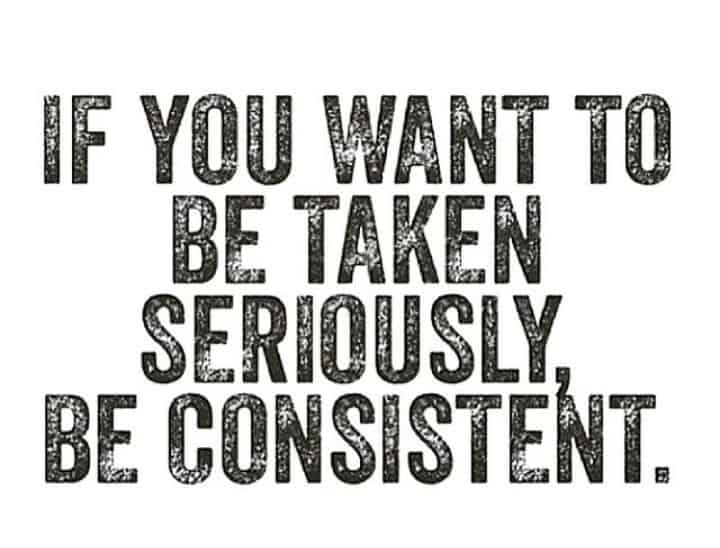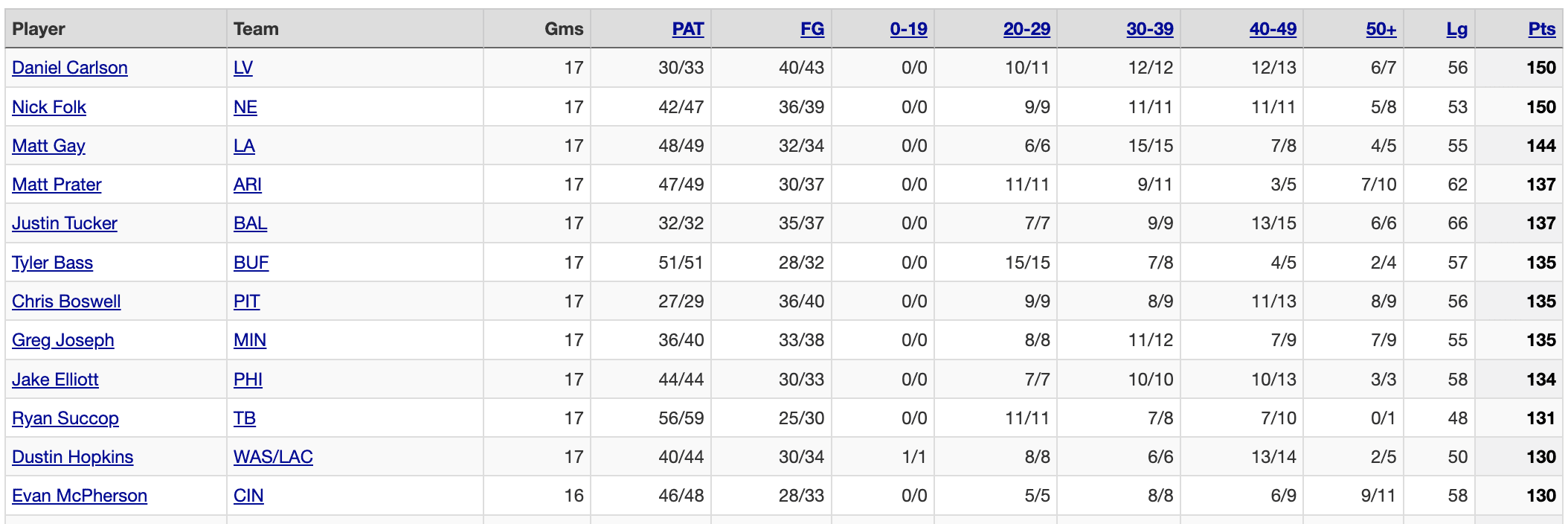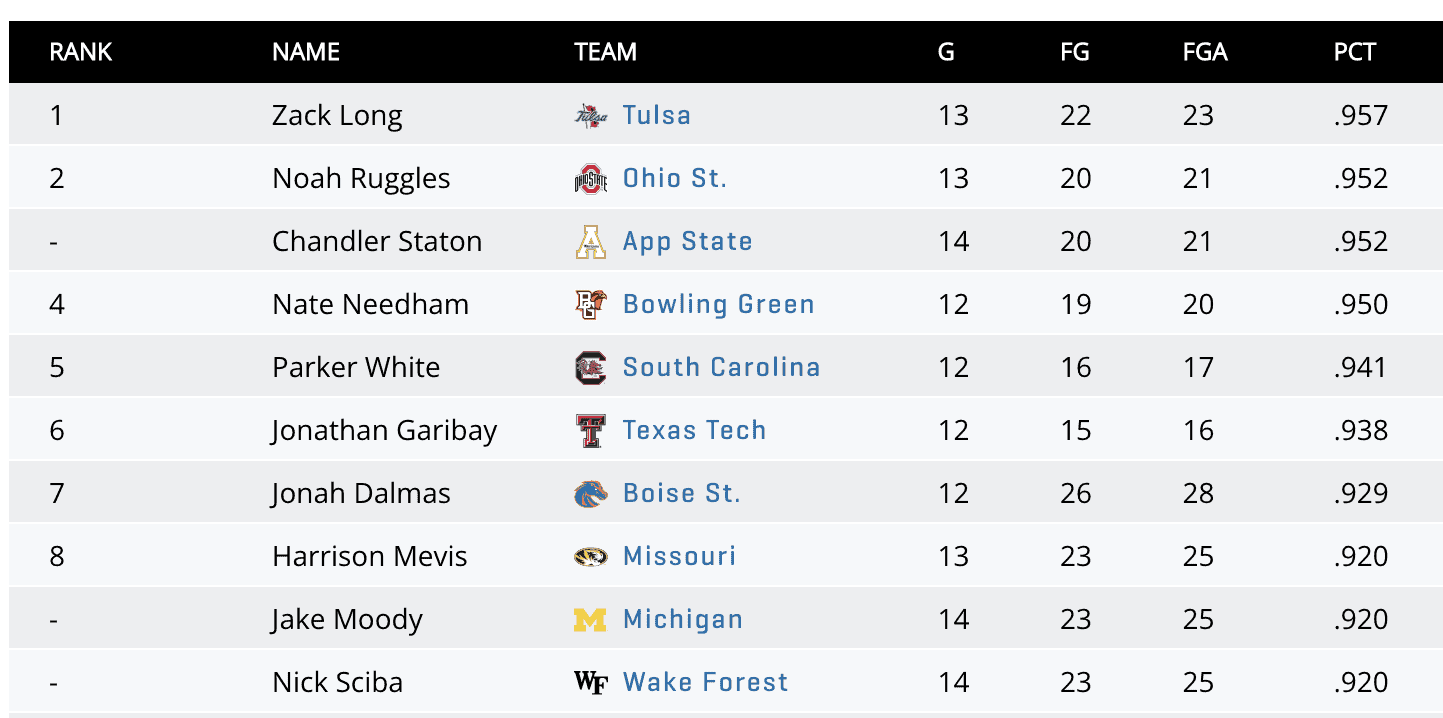It’s the hardest thing to master
And let me just say for the record, if I were more consistent, I would have stayed in the NFL. The hard truth was, I typically made 7 out of 10 and in the NFL… and that doesn’t cut it.
Take a look at last year’s kicking leaders stats:
(click to enlarge)
The most accurate kicker for 2021 was the Patriots’ Nick Folk (.947), followed by the Ravens’ Justin Tucker (.941) and the Raiders’ Daniel Carlson (.930). The lowest percentage on this chart of the Top 12 kickers who scored 130+ points last season is rookie Evan McPherson of the Bengals (.788).
Do you remember, there were rumors that McPherson’s job was in jeopardy until he went 12-for-12 in the post season. “Struggling” veteran kickers Jason Myers/SEA (.739), Mason Crosby/GB (.735) and Chase McLaughlin/CLE (.714) will all be battling for their jobs in pre-season in 2022.
Can you imagine, going better than 7-for-10 potentially gets you the boot?
I can.
What about the NCAA? Just as phenomenal…
(click to enlarge)
So how on earth do you find the ability for robot-like perfection?
If I truly knew, I probably wouldn’t be writing this blog… BUT, I can get you to 70% of the way — and perhaps you can get to the mountain top.
Here are most of the steps along the way:
1. You have to perfect your technique to consistently strike the ball well. There’s only about 1,000 kicks or more to get you to a place where you feel confident in believing that you can make the kick. Until your technique is consistent, you won’t find FG consistency.
2. When you practice, make EVERY kick count. When you step on to the field, put your game face on and work to limit all excuse-making to zero. Each kick needs to go through the posts. Make it your mission starting right now.
3. When setting up to kick, TAKE YOUR TIME. Put the tee down, find the placement and consistently take your steps back and STOP. For soccer-style kickers (which is just about everyone), this is your only chance to see the spot and the posts directly. Pick out your target behind the posts — a very small target — “aim small, miss small”… then take your steps over to your set-up stance.
4.Think “get a good strike on the ball”… NOT head down, shoulders square, good follow through, etc. Trust that the 1,000+ kicks meant something. If not, go back to step #1.
5. Relax… and literally, loosen up your butt. There’s enough pressure for everyone, it’s your reminder to take a breath, see your holder and give him a head nod that you’re ready for action.
6. The “GO” point for most kickers is when the holder’s spotting hand leaves to catch the snap. It’s that simple. Trust that the snap and hold will be good… and if it isn’t, you’ll adjust as best you can. Worrying about a process that you have ZERO control over is harmful to your chances. (Just ask Mason Crosby) That’s why you need to work with your team to gain that kind of trust.
7. Lastly, EXPECT to make the kick. Don’t sabotage your chances… visualize success. When you’re “in the zone”, you feel like you can’t miss. After you’ve missed a kick, it’s crazy hard to let it all go and get back to step #1, but that’s what the best do. A slump for them, is missing ONE kick. That’s why your go-to mantra should simply be “get a good strike on the ball”.
That’s all you need to do. The rest will take care of itself.
Of course, there’s more to this story, but this is a pretty good starting point that hopefully will get you down the proper path toward greater consistency and accuracy.



